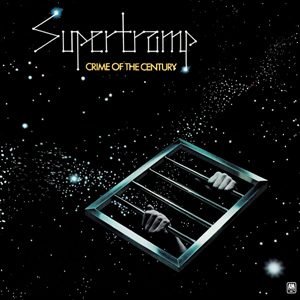Released in 1974, Crime of the Century marked a pivotal moment for Supertramp, both musically and thematically. The album is often hailed as their breakout, a dramatic evolution from their earlier, more experimental albums. Supertramp’s first two records, Supertramp (1970) and Indelibly Stamped (1971), received lukewarm reception, leaving the band searching for a definitive sound. Crime of the Century was their answer—a bold fusion of progressive rock, pop sensibilities, and introspective lyricism that showcased their distinct identity for the first time. It wasn’t just a progression; it was a reinvention.
This album arrived during a period when the boundaries of rock were being redefined. Progressive rock bands like Pink Floyd, Genesis, and Yes were pushing the limits of composition and narrative storytelling in music. However, while Crime of the Century bore the hallmarks of prog—complex arrangements, thematic coherence, and virtuosity—it also stayed rooted in more accessible melodic structures, creating a bridge between the sprawling ambition of concept albums and the immediacy of pop. This balance would become a hallmark of Supertramp’s future work.
Artistic Intentions
As for the album’s artistic intentions, band co-leaders Roger Hodgson and Rick Davies used Crime of the Century to explore universal themes of alienation, mental health, and societal pressure. The album feels like an existential inquiry, each track delving into the isolation of modern life and the desire to break free from oppressive systems—whether they be internal or external. While Hodgson and Davies had differing songwriting styles (Hodgson being more spiritual and reflective, Davies more grounded and cynical), the tension between their perspectives is what makes the album so compelling. Together, they crafted an atmospheric, almost cinematic experience, offering both a critique of society and a deeply personal exploration of the human condition.
Sonic Exploration

Crime of the Century is a masterclass in sonic craftsmanship, with production values that reflect the meticulous attention Supertramp gave to creating a cohesive, immersive sound. Produced by Ken Scott, who had previously worked with the likes of David Bowie and The Beatles, the album’s production is crisp and dynamic, balancing intricacy with accessibility. The clarity of the mix allows each instrument to shine in its own space, giving the album a pristine, polished feel while still maintaining a sense of warmth and organic cohesion. This clarity not only enhances the complexity of the arrangements but also amplifies the emotional weight of the songs, as the production mirrors the album’s thematic focus on internal and societal tension.
The production plays a critical role in setting the mood for the record. The sonic atmosphere is rich and expansive, full of wide dynamic ranges that give songs like “School” and “Rudy” a sense of both grandeur and intimacy. The quieter moments—delicate piano lines, understated acoustic guitar sections—are given as much care as the more explosive crescendos. This attention to space and nuance allows the themes of isolation and inner conflict to resonate more deeply with the listener. The album uses sonic contrasts—between soft and loud, simple and complex—to reflect the emotional rollercoaster the lyrics present, making the production not just a technical achievement but an integral part of the storytelling.
Musical Arrangements
The arrangements throughout Crime of the Century are some of the most intricate and memorable in Supertramp’s catalog. The band employed a wide range of instruments, from the signature Wurlitzer electric piano to grand pianos, soaring saxophones, and layered harmonies, all of which add a depth and texture that elevate the album beyond conventional rock. Rick Davies’ piano work is particularly central to the album’s sound, weaving through every track, providing both rhythmic foundation and melodic complexity. In “Bloody Well Right,” for example, the jazz-tinged piano intro seamlessly shifts into a guitar-driven rocker, showcasing Supertramp’s ability to merge genres with ease.
The vocal interplay between Roger Hodgson and Rick Davies is another standout element. Their contrasting voices—Hodgson’s high, ethereal tenor and Davies’ gruffer, grounded baritone—create a duality that mirrors the album’s thematic exploration of conflict and contrast. Tracks like “Dreamer” take full advantage of this, with Hodgson’s falsetto and urgent delivery bouncing over a percussive piano line, while Davies provides a more solid anchor in the harmonies. The instrumental build-up in songs like “Rudy,” where orchestration swells to a cinematic climax, displays the band’s deftness at creating drama through arrangement.
Genre Elements
Supertramp’s Crime of the Century straddles several musical genres, but its foundation is in progressive rock, with clear influences from art rock and symphonic rock. While it features the complex structures and thematic cohesion associated with progressive rock, it also integrates elements of jazz, pop, and classical music, making the album feel both sophisticated and accessible. Tracks like “Asylum” and “Hide in Your Shell” include extended instrumental passages and dynamic shifts that are hallmarks of prog, but with melodies that remain memorable and emotionally resonant.
The band’s use of pop-friendly structures—especially on songs like “Dreamer”—imbues the album with an immediacy that many of their prog-rock contemporaries often eschewed. Supertramp manages to balance accessibility and ambition, blending styles in a way that doesn’t feel forced. Saxophone solos, courtesy of John Helliwell, infuse jazz overtones, particularly in “Bloody Well Right” and “Rudy,” adding a sophisticated edge. The subtlety of these genre blends gives the album a unique identity within the progressive rock canon, marking Crime of the Century as a defining moment in Supertramp’s ability to craft music that was both artistically daring and commercially viable.
Lyrical Analysis

Crime of the Century delves deeply into existential themes, with the lyrics serving as a vehicle for exploring alienation, disillusionment, and the search for meaning in a world that feels confining and indifferent. Throughout the album, Roger Hodgson and Rick Davies weave together narratives that critique societal expectations, mental health struggles, and the overwhelming pressure to conform. The songs are often told from the perspective of characters grappling with personal crises, lending the album an introspective and sometimes bleak tone.
Themes and Messages
At its core, Crime of the Century grapples with feelings of isolation and the human desire to break free from societal and psychological constraints. The album paints a vivid picture of characters trapped by external pressures—whether it’s the rigid structures of education (“School”) or the rat race of modern life (“Rudy”). The opening track, “School,” critiques the stifling nature of institutionalized learning, portraying it as a microcosm of a system that suppresses individuality and creativity. The haunting chorus, “You’re coming along,” hints at the inevitability of being pulled into the system, a recurring motif of inescapability that surfaces throughout the album.
Similarly, “Rudy” presents a character aimlessly drifting through life, disconnected from others and uncertain of his place in the world. The train imagery in the lyrics serves as a metaphor for Rudy’s sense of entrapment and lack of direction, a theme mirrored by the frenetic musical arrangement. The title track, “Crime of the Century,” closes the album with an ominous indictment of societal corruption and hypocrisy. The lyrics—”Who are these men of lust, greed, and glory? Rip off the masks and let’s see”—suggest that the true crime is the societal system itself, which crushes the individual under the weight of its demands.
Lyrical Depth
The lyrics of Crime of the Century are highly poetic and multifaceted, often walking the line between narrative and abstraction. Hodgson and Davies employ vivid imagery, metaphor, and symbolism to convey their themes, allowing listeners to interpret the lyrics in different ways. In “Hide in Your Shell,” Hodgson offers a message of empathy to those struggling with inner turmoil, using metaphors of masks and protective shells to illustrate how people hide their pain from the world. The lyrics, “Love is the answer, makes no difference what you have heard,” provide a glimmer of hope amidst the darkness, suggesting that human connection might be a way out of isolation.
Songs like “Asylum” take a more abstract approach, where the protagonist’s descent into madness serves as an allegory for the collapse of mental stability under pressure. The repeated refrain “Don’t arrange to have me sent to no asylum” conveys both desperation and denial, leaving the listener to question whether the protagonist is truly losing touch with reality or if society is driving him to it. The ambiguity in these lyrics deepens the emotional and intellectual engagement with the album, as it leaves much to the imagination and personal interpretation.
Emotional Impact
The emotional resonance of Crime of the Century comes not just from the themes themselves, but from the way the lyrics explore human vulnerability with raw honesty. The characters depicted in the album’s songs are deeply flawed, struggling to make sense of a world that often seems indifferent to their suffering. This sense of alienation and yearning for connection is profoundly relatable, making the album resonate on a universal level.
In songs like “Dreamer,” Hodgson’s falsetto vocals and manic delivery convey a sense of youthful frustration and idealism, capturing the listener’s empathy even as the lyrics remain somewhat ambiguous. On the other hand, “If Everyone Was Listening” evokes a deep melancholy, as it reflects on the fleeting nature of life and the illusion of control. The lyrics, “The show must go on / It will always be wrong,” touch on the futility of trying to make sense of a world that is constantly shifting, adding a layer of sadness and resignation to the track.
Cohesion and Flow

One of the defining strengths of Crime of the Century is its remarkable cohesion, both musically and thematically. From the first track to the last, the album unfolds like a meticulously crafted journey, with each song contributing to a larger emotional and conceptual narrative. While the album does not tell a literal, linear story in the vein of a rock opera, it masterfully builds on its central themes of alienation, existential angst, and societal critique, creating an overarching sense of progression as the listener moves from one track to the next.
Track Progression
The flow of Crime of the Century is deliberate, with each song feeling like a natural extension of the one before it. The opening track, “School,” immediately sets the tone with its slow, haunting intro—featuring distant harmonica and atmospheric sounds that build into a powerful, cathartic chorus. It’s a perfect introduction to the album’s themes of confinement and rebellion. The transition from “School” to “Bloody Well Right” is seamless, despite the latter’s harder, more cynical edge. Together, they function as a one-two punch, confronting both the stifling nature of authority (school, institutions) and the bitterness that follows when attempting to fight back.
As the album progresses, the emotional stakes intensify. “Hide in Your Shell” and “Asylum” delve deeper into personal isolation and mental instability, providing an emotional anchor in the middle of the record. The way “Hide in Your Shell” softly fades into the more theatrical “Asylum” creates a subtle, haunting progression from vulnerability to outright despair, maintaining the listener’s emotional engagement.
“Rudy” marks a turning point in the album, both thematically and musically. Its shifting time signatures and cinematic feel take the listener on a journey of existential wandering, which mirrors the album’s larger exploration of feeling lost in the world. The orchestral crescendo towards the end of “Rudy” brings a sense of climactic release, yet there’s a lingering sense of unresolved tension, which bleeds into the introspective “If Everyone Was Listening.”
The album closes with the titular track, “Crime of the Century,” which feels like the culmination of everything that came before it. The tension built throughout the album finally explodes into a dramatic and chilling finale. The final lyrics—”Who are these men of lust, greed, and glory? / Rip off the masks and let’s see”—are a poignant reflection of the album’s critique of societal structures, while the swelling orchestration and haunting piano outro leave the listener with a feeling of unresolved questions, a fitting end to an album that thrives on introspection and ambiguity.
Thematic Consistency
Crime of the Century maintains an impressive thematic consistency from start to finish. Each song, though distinct in its musical approach, contributes to the album’s exploration of disillusionment and the search for meaning. Whether the focus is on the individual’s battle against internal demons (as in “Hide in Your Shell” or “Asylum”) or broader societal critiques (as in “School” and “Crime of the Century”), there’s a recurring sense of conflict—between self and society, desire and reality, hope and disillusionment—that ties the album together.
Even on tracks where the musical style shifts—like the jazzy swagger of “Bloody Well Right” or the pop-inflected energy of “Dreamer”—the album never feels disjointed. Instead, these variations in style serve the larger emotional arc of the record, representing different aspects of the same underlying tensions. The stylistic shifts between tracks like “Dreamer” and the somber “Rudy” feel more like changes in perspective rather than mood swings, giving the album a dynamic, multifaceted character without sacrificing its thematic integrity.
Supertramp also uses recurring musical motifs and instrumental flourishes to reinforce the album’s cohesiveness. The prominent use of the Wurlitzer piano, for instance, becomes a sonic signature that binds the songs together, while the orchestral elements, particularly on tracks like “Asylum” and “Crime of the Century,” provide a sense of grandeur and continuity.
In terms of emotional consistency, the album never veers too far from its core feelings of melancholy, frustration, and longing for escape. Even the seemingly more upbeat “Dreamer” carries an underlying sense of restlessness and unfulfilled desire, ensuring that the album’s emotional tone remains unified. Despite the individual journeys of each track, there’s a palpable throughline of unresolved tension that runs throughout the entire record, making Crime of the Century feel like a cohesive work of art rather than a collection of disparate songs.
Standout Tracks and Moments
https://youtu.be/TonrjcyshVk?si=uCgxwFJwi9iC8WKw
Crime of the Century is an album filled with memorable moments, each track contributing something unique to the overall experience. However, a few tracks stand out as particularly impactful, either for their artistic innovation, emotional depth, or musical complexity. These key tracks not only define the album’s sonic landscape but also crystallize its central themes of alienation and existential struggle.
Highlight Key Tracks
“School”
The album opener, “School,” is one of Crime of the Century‘s most iconic tracks. From its eerie, distant harmonica introduction to the explosive, anthemic choruses, “School” sets the tone for the entire album. It addresses the stifling nature of institutionalized education, which serves as a metaphor for the broader theme of societal oppression. The song’s dynamic shifts—from the delicate verses to the raucous, distorted guitar solo—create a sense of emotional urgency. What sets this track apart is how it captures the frustrations of adolescence, speaking to a universal sense of rebellion and disillusionment that remains relatable decades later.
“Rudy”
“Rudy” stands out for its cinematic quality and complex arrangement. The track is a journey in itself, shifting between moods and tempos to mirror the aimless life of its protagonist. The jazzy piano lines, orchestral swells, and driving rhythm section give the song an epic scope, with the instrumental crescendo toward the end acting as one of the album’s most climactic moments. Rudy’s existential wandering—embodied in the train imagery—offers a poignant representation of the alienation and lack of purpose that permeates much of the album. It’s a standout in both narrative and musical execution, with each section of the song building toward a cathartic release.
“Crime of the Century”
The title track serves as the album’s grand finale, both musically and thematically. It begins with a haunting piano motif that gradually builds into a full-blown orchestral climax, complete with soaring strings and dramatic percussion. The lyrics—“Who are these men of lust, greed, and glory? / Rip off the masks and let’s see”—offer a sharp critique of societal corruption, giving the song a sense of gravitas and urgency.
The instrumental build-up in the closing moments is breathtaking, with each layer adding to the emotional intensity until the album closes with a final, unresolved chord. The sheer scale and ambition of this track make it a fitting conclusion to the album’s exploration of existential and societal themes.
Memorable Moments
The harmonica intro in “School”
The distant, almost ghostly harmonica that opens “School” immediately transports the listener into a world of quiet tension and impending rebellion. This simple, haunting melody sets the stage for the album’s overarching themes of confinement and escape, acting as a subtle but powerful prelude to the storm of sound that follows. It’s a brilliant example of using silence and minimalism to create atmosphere.
The vocal interplay in “Dreamer”
“Dreamer” is a high-energy track driven by Roger Hodgson’s playful falsetto and lively Wurlitzer piano. The back-and-forth vocal lines between Hodgson and Rick Davies create a dynamic tension that mirrors the song’s theme of youthful idealism clashing with reality. Hodgson’s soaring delivery, combined with the bright, bouncy arrangement, makes this song one of the most instantly memorable moments on the album. Despite its upbeat tempo, the underlying restlessness in the lyrics prevents it from feeling out of place in the album’s darker thematic context.
Orchestral crescendo in “Rudy”
One of the album’s most powerful musical moments comes toward the end of “Rudy.” The orchestral arrangement swells, driving the song to a dramatic climax as the character’s existential wandering reaches its peak. The use of strings here adds a cinematic grandeur to the song, enhancing the sense of Rudy’s internal chaos and emotional turmoil. This crescendo encapsulates the album’s fusion of rock and orchestral elements, showcasing Supertramp’s ability to create epic, emotionally charged soundscapes.
The piano outro in “Crime of the Century”
The album’s final moments—following the orchestral explosion of the title track—are perhaps its most haunting. The piano outro, a solitary melody that slowly fades into silence, leaves the listener with a sense of unresolved tension. It’s a brilliant use of space and minimalism, acting as a quiet counterpoint to the bombast that came before it. This moment perfectly captures the essence of the album, leaving its themes of alienation and societal critique lingering in the air, unresolved but unforgettable.
Artistic Contribution and Innovation

Place in Genre/Industry
Crime of the Century holds a significant place within the progressive rock movement of the 1970s, but it also defies easy categorization. While many of their contemporaries, like Pink Floyd, Genesis, and Yes, were delving deeper into sprawling, experimental compositions, Supertramp forged a path that balanced the complexity of progressive rock with the accessibility of pop and rock songwriting. This ability to straddle genres allowed Crime of the Century to reach a broader audience, and it became one of the albums that helped define Supertramp’s identity as more than just another prog band.
In terms of the music industry, Crime of the Century was a breakthrough not only for Supertramp but for art rock at large. It helped cement the idea that ambitious, conceptually-driven albums could achieve commercial success without sacrificing artistic integrity. This was a time when the album format was becoming a statement in itself, and Crime of the Century exemplified the trend of treating the LP as a unified artistic work rather than just a collection of singles. As a result, the album stood out in the mid-1970s, when mainstream rock was dominated by either straightforward arena rock or deeply experimental prog that often alienated casual listeners.
By creating a record that was thematically cohesive and musically adventurous yet still packed with memorable hooks and radio-friendly moments, Supertramp managed to push boundaries within the prog rock genre while also appealing to a more mainstream rock audience. In this way, Crime of the Century served as a bridge between the increasingly complex structures of 1970s prog and the melodic sensibilities of rock and pop, positioning it as a genre-bending album that appealed to fans across the musical spectrum.
Innovation
Supertramp’s Crime of the Century was innovative in several key ways, particularly in its approach to thematic exploration and its fusion of genres. One of the album’s most striking innovations is its balance of intricate, progressive arrangements with clear, memorable melodies. Tracks like “Rudy” and “Asylum” feature unconventional song structures, shifting time signatures, and dynamic instrumentals, yet they remain emotionally grounded and easy to connect with, thanks to their strong melodic foundations.
The album’s production also set it apart. Ken Scott’s meticulous, crystal-clear mix allowed every instrument to shine, with the Wurlitzer electric piano becoming a sonic signature of the album. This instrument wasn’t a staple in most progressive rock at the time, and its use on Crime of the Century helped define Supertramp’s unique sound, offering a warmer, more grounded contrast to the synthesizer-heavy arrangements found in many other prog rock albums. The way the production manages to seamlessly blend orchestral elements, piano-based rock, and electronic flourishes was ahead of its time, laying the groundwork for many later bands who sought to combine classical and modern rock influences.
Thematically, Crime of the Century was innovative in its existential, almost cinematic storytelling approach. Rather than creating a narrative concept album in the traditional sense, Supertramp used recurring themes of isolation, societal critique, and personal struggle to tie the album together. This allowed the album to function as both a cohesive piece of art and a collection of individual stories that each listener could interpret and relate to in their own way. The title track, with its enigmatic lyrics and dark indictment of society, felt both personal and universal—creating a sense of grandeur while remaining introspective.
Another key innovation was how Supertramp integrated complex orchestration into the rock framework without overshadowing the core band sound. Tracks like “Rudy” and “Crime of the Century” feature lush orchestral arrangements that elevate the emotional impact of the songs, yet the rock elements—guitar, piano, drums—remain central. This blending of orchestral and rock instrumentation was not unheard of in prog, but Supertramp’s execution felt more integrated and seamless than many of their peers. The orchestra wasn’t merely an embellishment but a fully integrated part of the music’s emotional and thematic narrative.
Closing Thoughts

Crime of the Century stands as a landmark achievement not only in Supertramp’s discography but also in the landscape of 1970s rock music. The album’s strengths lie in its seamless blending of progressive rock’s ambition with pop’s accessibility, making it a richly textured yet emotionally resonant listening experience. From the pristine production and complex arrangements to the deeply introspective lyrics, every element of the album serves its overarching themes of alienation, societal pressure, and existential questioning.
Musically, the album offers innovation at every turn. The band’s masterful use of dynamic shifts, orchestration, and instrumental diversity provides an immersive soundscape that feels fresh even decades later. Tracks like “School” and “Rudy” are timeless in their exploration of individual isolation, while songs like “Dreamer” and “Bloody Well Right” offer energetic counterpoints, ensuring that the album’s flow remains engaging throughout. The vocal interplay between Roger Hodgson and Rick Davies adds another layer of depth, embodying the duality of hope and cynicism that runs through the album.
If there is a weakness to be found, it might lie in the album’s occasional reliance on darker, more melancholic tones, which can make it emotionally heavy at times. However, this is also what gives Crime of the Century its lasting emotional impact. The weight of the themes may not suit every listener, but for those who resonate with its introspective nature, the album offers a deeply rewarding and thought-provoking journey.
In the context of Supertramp’s career, Crime of the Century is arguably their defining work, the album that firmly established them as serious musicians capable of producing sophisticated, genre-blurring music. It was a turning point that led to greater commercial success with subsequent albums, but Crime of the Century remains the one that captured their artistic vision at its most cohesive and profound.
Official Rating
This album earns a perfect 10 not just for its technical mastery, but for the way it pushes boundaries without ever losing its emotional core. Every track feels essential to the album’s overarching narrative, and the production is meticulous without being sterile. It’s an album that appeals to both the mind and the heart, offering layers of meaning that reward multiple listens.
Supertramp managed to create a work that was both artistically ambitious and universally relatable, making Crime of the Century not just one of the best albums of the 1970s, but a timeless masterpiece. Its lasting influence on both progressive and mainstream rock, coupled with its emotional depth, secures its place as a 10/10 in the pantheon of rock albums.
